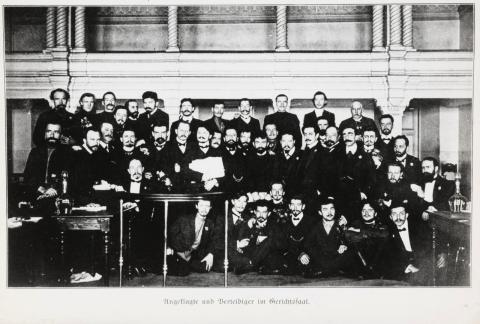Submitted by ICConline on
St Petersburg Soviet, 1905
In 1905, in Russia, a wave of spontaneous strikes erupted on an unprecedented scale with a spectacular outburst of workers' anger and a heightened class consciousness that heralded a new form of struggle for the proletariat: the mass strike. This upsurge of the masses was a source of inspiration for the revolutionaries of the time, like Rosa Luxemburg, Trotsky and Lenin who drew essential lessons for the class struggle from it, in their fierce fight with the reformists.
At a time when the working class had still not regained consciousness of its strength, when it woefully lacked confidence in its abilities and political potential, the 1905 revolution bore witness to its real historical power and its essential creativity: "The sudden general rising of the proletariat in January under the powerful impetus of the St. Petersburg events was outwardly a political act of the revolutionary declaration of war on absolutism. But this first general direct action reacted inwardly all the more powerfully as it for the first time awoke class feeling and class-consciousness in millions upon millions as if by an electric shock. And this awakening of class feeling expressed itself forthwith in the circumstances that the proletarian mass, counted by millions, quite suddenly and sharply came to realise how intolerable was that social and economic existence which they had patiently endured for decades in the chains of capitalism,” (Rosa Luxemburg, The Mass strike, the political party and the trade unions).
This historical experience, although mostly forgotten, remains a reference of the first order for the world proletariat, for its struggles and its revolutionary future. And this is what Lenin had already seen, when, as one of the rare people to have grasped the meaning and significance of the emergence of the first workers' councils in history, he wrote that it was the “finally found form of the dictatorship of the proletariat”. This was no more and no less than a modus operandi for the class struggle initiated at the high point of capitalism, and which would become the modus operandi throughout its phase of decline, right up to the proletarian revolution of the future. An in-depth understanding of the significance of the events of 1905, the prelude to the Red October of 1917, was indeed one of the preconditions for the seizure of power in Russia.
Today, the lack of a wider perspective for the great mass of workers, who are now returning to the struggle after more than three decades of inactivity, tends to limit their actions to their immediate circumstances. In this sense, highlighting the experience of the great struggles of the workers' movement, such as the events of 1905 in Russia, remains vital to the ongoing process of reflection, and to the to the maturation of its consciousness, in order to connect it once more to a whole historical heritage. 1905 was not like a thunderstorm bursting out from a clear blue sky! The event could only have arisen as a result of a whole body of previous experience, in particular a whole process of subterranean maturation, of political assimilation, of slow and long reflection that followed major struggles, particularly in St Petersburg and elsewhere during the 1890s.
Today, even if the context is radically different, there is also an in-depth reflection tending to develop within the working class. After 1968 and during the various waves of struggles that followed, particularly those of the 1980s, a decisive breakthrough was needed, and unfortunately not taken: the politicisation of struggles. Today, it is in the terribly more difficult context of decomposition that the proletariat is once again engaging in a reflection that must be successful in raising its level of consciousness and its commitment, without which capitalism will engulf the whole of humanity in barbarism and destruction.
The mass strike in 1905 was not an isolated phenomenon. It was accompanied by struggles all over Europe. Today, a new generation of proletarians is also taking up the struggle all over the world, particularly since the strikes of the “Summer of Discontent” in Great Britain in 2022. This generation belongs to the long chain of fighters that has links to the first struggles of our class, with the capability of developing its consciousness and raising it to a higher level. This non-linear process, with phases of development, the ebb and flow, has characterised the struggle since the dawn of the workers' movement. By republishing the International Review's series of articles on the 1905 revolution, together with a new article written in July 2025, we hope to contribute to these efforts, which are currently being led by the working class. We want to encourage the process of in-depth maturation, on a difficult, slow and bumpy road, in the attempt to reconnect with the communist perspective, with the revolutionary struggle against a capitalist world that history has condemned.
- 1905: When the working class in Russia demonstrated its revolutionary nature, published by ICConline, July 2025
- 100 years ago: the 1905 revolution in Russia, published in International Review n°120
- 1905: The soviets open a new period in the history of the class struggle, published in International Review n°122
- 100 years ago: the Russian revolution of 1905 and the Soviet of workers' deputies, published in International Review n°123
- The debate in the revolutionary vanguard on the implication of the 1905 revolution, published in International Review n°125
ICC







 del.icio.us
del.icio.us Digg
Digg Newskicks
Newskicks Ping This!
Ping This! Favorite on Technorati
Favorite on Technorati Blinklist
Blinklist Furl
Furl Mister Wong
Mister Wong Mixx
Mixx Newsvine
Newsvine StumbleUpon
StumbleUpon Viadeo
Viadeo Icerocket
Icerocket Yahoo
Yahoo identi.ca
identi.ca Google+
Google+ Reddit
Reddit SlashDot
SlashDot Twitter
Twitter Box
Box Diigo
Diigo Facebook
Facebook Google
Google LinkedIn
LinkedIn MySpace
MySpace